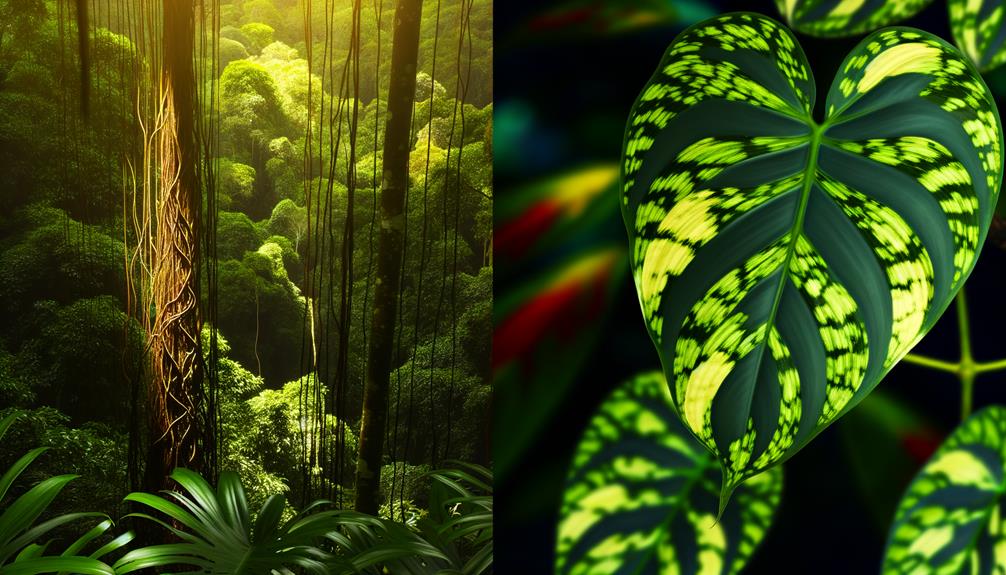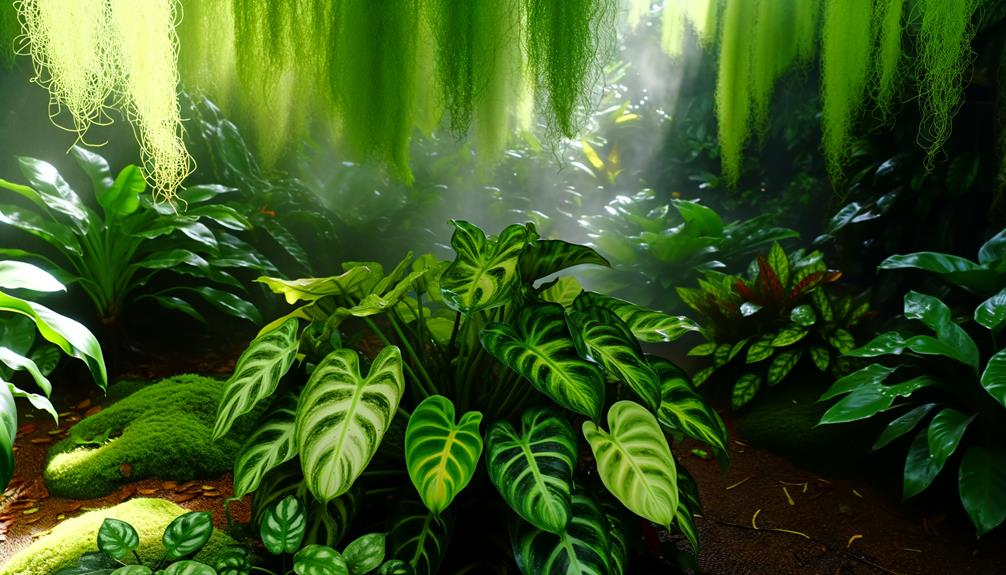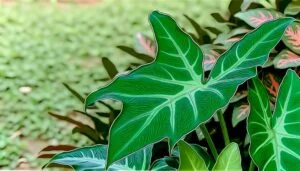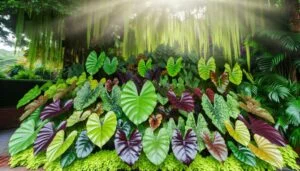What Is a Variegated Philodendron Plowmanii?
The Variegated Philodendron Plowmanii is a distinguished epiphytic species from the tropical rainforests of South America, belonging to the Araceae family. This plant features heart-shaped leaves exhibiting variegation—a phenomenon caused by genetic mutations affecting chlorophyll distribution, resulting in exquisite green, cream, yellow, and pink hues.
It thrives under bright, indirect light, high humidity (60-80%), and temperatures ranging from 65-80°F (18-27°C). Well-draining, organic-rich soil is paramount for its growth.
Consistent care, including balanced watering and bi-monthly fertilization, is essential to maintain its health. For more insights into its unique characteristics and proper cultivation techniques, continue on.

Key Takeaways
- Variegated Philodendron Plowmanii is an epiphytic plant from South American rainforests.
- It features heart-shaped leaves with unique variegation in green, cream, yellow, and sometimes pink hues.
- Named after botanist Timothy Plowman, it belongs to the Araceae family.
- The plant thrives in bright, indirect sunlight with high humidity and well-draining soil.
- Common pests include spider mites and aphids; it is also prone to root rot and leaf spot diseases.
Origins and History

The Variegated Philodendron Plowmanii, a striking cultivar within the Araceae family, traces its origins to the tropical rainforests of South America, particularly in regions such as Ecuador and Peru.
This epiphytic plant thrives in humid, shaded environments, attaching to trees and deriving nutrients from organic debris. Named in honor of botanist Timothy Plowman, it belongs to the genus Philodendron, known for their climbing and sprawling growth habits.
Historically, the plant has been studied for its adaptive morphology, which includes heart-shaped leaves and a robust root system. These morphological traits enable it to survive in the nutrient-poor substrates typical of its native habitat.
Understanding its ecological niche provides insights into its cultivation and care in non-native environments.
Unique Variegation Patterns
Characterized by intricate and diverse colorations, the unique variegation patterns of the Variegated Philodendron Plowmanii result from genetic mutations affecting chlorophyll distribution in the leaves.
These mutations lead to varied pigmentations, producing a mosaic of green, cream, yellow, and sometimes pink hues. The variegation is typically sectorial, where distinct patches of non-green tissue contrast sharply with chlorophyll-rich areas.
This visual phenomenon is due to chimeral cells within the leaf structure, where mutated cells lack chloroplasts entirely or partially. The resulting effect is not only aesthetically striking but also biologically significant, as it reduces photosynthetic efficiency.
Consequently, the plant's growth rate and overall vigor are directly influenced by the extent and nature of these variegated patterns.
Ideal Growing Conditions

Ideal growing conditions for Variegated Philodendron Plowmanii necessitate precise control of light, humidity, temperature, and soil composition to maximize healthy growth and vibrant variegation.
Optimum light levels involve bright, indirect sunlight, preventing direct exposure which can scorch the leaves.
Humidity should be maintained between 60-80%, mimicking its native tropical environment.
Temperature control is crucial, with ideal ranges between 65-80°F (18-27°C), avoiding cold drafts and sudden fluctuations.
Soil composition must be well-draining and rich in organic matter; a blend of peat, perlite, and orchid bark is recommended to guarantee aeration and moisture retention.
These conditions collectively foster robust growth and enhance the striking variegation patterns characteristic of this species.
Plant Care Tips
Maintaining best care for Variegated Philodendron Plowmanii involves meticulous attention to watering schedules, pest management, pruning techniques, and nutrient supplementation. Ideal hydration requires a balance, ensuring soil remains moist but not waterlogged. Employing a well-draining potting mix mitigates root rot. Pruning promotes healthy growth and necessitates sterilized tools to prevent pathogen transmission. Nutrient needs are met with balanced, water-soluble fertilizers applied bi-monthly during the growing season.
| Care Aspect | Recommendation |
|---|---|
| Watering | Keep soil moist, avoid waterlogging |
| Potting Mix | Use well-draining, aerated substrate |
| Pruning | Sterilize tools, remove dead/diseased foliage |
| Fertilization | Apply balanced, water-soluble fertilizer bi-monthly |
Regular monitoring and adjustments based on environmental conditions are essential for sustaining plant vitality.
Common Pests and Diseases

Variegated Philodendron Plowmanii, like many tropical plants, is susceptible to common pests such as spider mites, aphids, and mealybugs, as well as diseases like root rot and leaf spot.
Spider mites can cause stippled and discolored leaves by sucking plant sap, while aphids and mealybugs secrete honeydew, leading to sooty mold.
Root rot, often caused by overwatering and poor drainage, results in blackened, mushy roots. Leaf spot manifests as brown or black lesions, usually due to fungal or bacterial infections.
- Spider Mites: Minute arachnids causing leaf stippling.
- Root Rot: Fungal disease leading to root decay.
- Leaf Spot: Fungal or bacterial infection causing lesions.
Effective pest and disease management involves regular inspection, prompt treatment, and maintaining ideal growing conditions.
Propagation Methods
Propagating Philodendron Plowmanii primarily involves stem cuttings and air layering to guarantee genetic consistency and promote vigorous growth. Stem cuttings should be taken from healthy, mature plants, making sure nodes are included, as these are essential for root development.
Place the cuttings in a well-draining medium and maintain high humidity to expedite root formation. Air layering entails creating a small incision on a stem, wrapping it with moist sphagnum moss, and covering it with plastic to retain moisture. Roots will develop at the wound site within several weeks.
Both methods preserve the variegated phenotype and secure robust progeny. These techniques, when executed with precision, optimize the success rate of propagating this exquisite cultivar, securing its continued aesthetic and horticultural value.
Conclusion
In summary, the diverse Philodendron plowmanii, with its colorful foliage and strong adaptability, serves as a botanical wonder that flourishes in regulated settings.
Proficiency in its growth, from best light conditions to careful propagation techniques, reveals a canvas of chlorophyll artistry.
Diligence against pests and diseases guarantees the durability of its lush beauty.
The plant's distinct variation and sturdy character make it a lively tribute to horticultural expertise and natural aesthetics.






